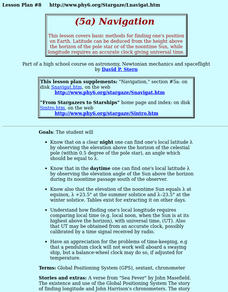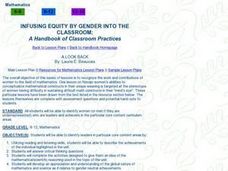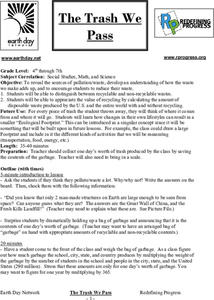Curated OER
How Distant is the Moon?--2
Pupils examine total eclipses of the Sun and their limited regions of totality. They explain that this limited view occurs because the Moon is close enough to us for different points on Earth to view it differently.
Curated OER
Navigation
Young scholars study the basic methods for finding one's position on Earth. Latitude can be deduced from the height above the horizon of the pole star or of the noontime Sun, while longitude requires an accurate clock giving universal time.
Curated OER
Graphing With RXTE
Learners use data from the Rossi X-ray Tiiming Explorer (RXTE) satellite to analyze and graph.
Curated OER
Using the Variation Approach
Young scholars explore and explain geometrical applications, and how to apply these applications to real life.
Curated OER
Geo Jammin' By DeSign - Day 6, Lesson 32: Appliqué-tion of Learning
Second graders hand stitch three different appliqué stitches using triangles as a motif.
Curated OER
Walk a Mile in Albatross Shoes
Students recognize the correlation between the trash they dispose of around their school and the environmental hazards that face wildlife, specifically the Laysan albatross. They determine three ways that they can help the albatross chicks.
Curated OER
Space Shapes
Students read "Captain Invincible and the Space Shapes" by Stuart Murphy and view a PowerPoint presentation on shapes. They identify shapes presented in the book and then identify shapes found in their classroom.
Curated OER
Roman Numerals
Studetns recognize Roman numerals and identify each symbol and what it stands for.
Curated OER
Hidden Jewels of Geometry
Pupils identify different geometric shapes, and arrange them artistically in original jewelry designs.
Curated OER
Collect, organize and compare different data for the Marine Mammals of the Miami Seaquarium, i.e.: size, weight, diet and habitat and how to calculate average, median, mode and range.
Learners collect, organize, and compare different data and develop statistical methods such as: average, median, mode and range as a way for decision making by constructing table
Curated OER
Painting a Mural
Pupils research create and design symbols to welcome students to their school. They present their idea to the class that includes a budget. The class work together to paint the mural.
Curated OER
Population Counts
Students investigate the analytical processes used to interpret the 2001 Canadian census. They examine the population statistics and trends.
Curated OER
Multiple Intelligences Holistic Plan
Ninth graders apply basic algebra concepts to equations using cognitive, affective, and kinesthetic components. They create their own word problem, perform the story problem using a dramatic presentation, and present the problem to the...
Curated OER
THe Trash We Pass
Learners identify the sources of pollution and waste in their community. They examine the process of recycling and how to eliminate some of their family waste.
Curated OER
Probability of a Boy
Learners investigate the concept of even change by participating in a coin flip activity. They research using the Internet to investigate the chance of giving birth to a boy.
Curated OER
Nickels, History, and Peace
Second graders examine the designs on nickels before 2004 and after when the new Peace Medal nickel was minted. They research the events that preceded the new design and explore the symbols of friendship on the new coin. They work in...
Curated OER
The Numbers Game
Students examine how to calculate the part-per-million and part-per-billion units used to measure contaminant concentrations in the environment. They calculate ratios, take a quiz, analyze a sample chemical spill, and determine if...
Curated OER
The Weather and Recess #157
Students track the daily weather at recess time for a number of weeks. They design a bar graph of the different types of weather. They discuss how weather changes affect recess time. They write a list of optional recess activities for...
Curated OER
American Political Thought: Minority Influence
Sixth graders brainstorm the reasons why people would want to leave their homeland to live in the United States. In groups, they research the political representation of the Board in New Haven, Connecticut. They also write a paper on...
Curated OER
France
Eighth graders visit two websites about France in order to take a virtual trip of France. They answer specific questions about France and state the similarities and differences between France and the U.S.
Curated OER
All About Me
Third graders investigate the use of centimeters while measuring items with rulers which they construct. They examine the need for standard units of measure. They estimate the length of body parts before making the actual measurements.
Curated OER
A Fashion Extravaganza
Students decide what body measurements they need to make garments such as a pair of pants. They make a list, and work with a partner to take and record those measurements in centimeters. They discuss the use of centimeters.
Curated OER
Polygonal Strings
Sixth graders apply knowledge of how to calculate the area and perimeter of triangles. They determine why it is inappropriate to measure the area of land by its perimeter which is done in certain areas of New Guinea. They complete a...
Other popular searches
- Music Appreciation
- Art Appreciation
- Teacher Appreciation
- Music Appreciation Worksheet
- Classical Music Appreciation
- Music Appreciation Lessons
- Art Appreciation 3rd Grade
- Music Appreciation 9 12
- Popular Music Appreciation
- Beginning Music Appreciation
- Children Music Appreciation
- Cultural Music Appreciation

























